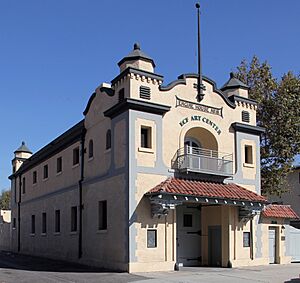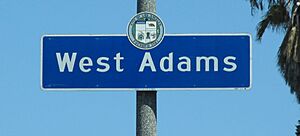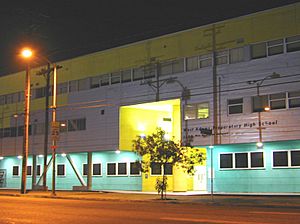West Adams, Los Angeles facts for kids
Quick facts for kids
West Adams
|
|
|---|---|
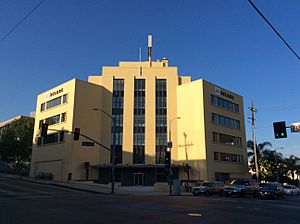
|
|
| Country | United States |
| State | California |
| County | Los Angeles |
| Time zone | Pacific |
| Zip Code |
90018
|
| Area code(s) | 213/323 |
West Adams is a neighborhood in the South Los Angeles region of Los Angeles, California. The area is known for its large number of historic buildings, structures and notable houses and mansions. It contains several Historic Preservation Overlay Zones as well as designated historic districts.
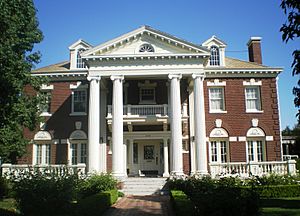
Contents
History
West Adams is one of the oldest neighborhoods in the city of Los Angeles, with most of its buildings erected between 1880 and 1925, including the William Andrews Clark Memorial Library. West Adams was developed by railroad magnate Henry E. Huntington and wealthy industrialist Hulett C. Merritt of Pasadena. It was once the wealthiest district in the city, with its Victorian mansions and sturdy Craftsman bungalows, and a home to Downtown businessmen, as well as professors and academicians at the nearby University of Southern California.
1880s - 1890s
In 1887, the Los Angeles Herald announced that the forthcoming St. James Park neighborhood would have a stone entrance to "rival the Arc de Triomphe" and would be eventually be surrounded by "the most costly residences yet erected on this coast". Named by George King and his wife, the couple donated the parkland to the city in commemoration of their many trips to London. The gated community of Chester Place was developed in 1889 On October 24, 1901, Edward L. Doheny purchased number 8 Chester Place for $120,000 cash.
In 1890, "St. Margaret's School for Girls" moved from Pasadena to the city of Los Angeles. On October 1, 1890, the school opened at the corner of 23rd and Scarff Streets. Occupying the empty Marlborough Hotel, the school adopted the name of its new location and was renamed the "Marlborough School for Girls". It remained in West Adams for 26 years before relocating to Hancock Park in 1916.
1900s - 1910s
In 1906, residents of the "exclusive West Adams" section experienced a water shortage because the new pipe from the Ivanhoe reservoir was not completed on time. The new reservoir would hold nearly "a billion gallons" of water. In September of that year, a Los Angeles Times reporter wrote: "The growing popularity of apartment houses is causing them to encroach on grounds heretofore exclusively reserved for high-class residences". He was reporting on "one of the handsomest apartment-houses in the city", which was designed by Thornton Fitzhue and was to be built on the southern side of St. James Park. . Landowner John R. Powers completed another apartment building in St. James Place in 1909, with an entrance also on Scarff Street. Designed by George W. Wryman, it was divided into four apartments of seven rooms each; the venture represented an investment of $35,000.
In 1913, the Times announced that the Monarch Hotel was to be built in the "fashionable residence district" of West Adams. By 1916, the Los Angeles Times stated that the area was "already known for its private parks and handsome homes". At that time, improvements to the boulevard were being spearheaded by five prominent residents including Isidore B. Dockweiler, William May Garland and Edward L. Doheny. After convincing thirty-five other residents to help with funding, the old street paving between Figueroa and Hoover streets was replaced with asphalt surface. Adams Boulevard was now 65 feet wide and in the middle were a series of islands planted with flowers, shrubs and mature palms. Six-cluster electroliers were installed on both sides of Adams Street, which were exact duplicates of those that lined Lake Shore Drive in Chicago. Adams Boulevard was now a "magnificent concourse" and "one of the most popular drives in Los Angeles".
1920s - 1930s
In 1921, the Automobile Club announced that it would build a new headquarters at Figueroa and Adams. Architects Sumner Hunt and S.R. Burns designed a building of "attractive Spanish design" that would be a "distinctive structure for the West Adams district".
In 1925, silent screen star Ramon Novarro purchased a home in "the exclusive West Adams district" for $12,000 and spent an additional $100,000 on renovations.
In 1927, during the prohibition era, the Times reported that the vice squad raided a "luxurious fourteen rooom mansion in the exclusive West Adams district". The mansion, located at 2234 Adams Street, contained "the most extensive and elaborate moonshine production plant" they had seen in many months.
In 1931, during the Great Depression, the recently organized "West Adams Relief Committee" provided work for twenty men for ninety days. Married men with families who lived in the district would and were registered voters would be paid $2 a day.
Though West Adams had previously been described as "fashionable" and "exclusive", in 1937 the Times wrote: "St James Place, Chester Place, Scarff Street - those place-names mean little to present day Angelinos. Yet they spell an aristocratic Los Angeles of the past, and to a good extent, the present. They are of the wealthy Los Angeles of a past generation, and a visitor to the neighborhood will find evidence of its elegance, if somewhat frayed and faded in spots."
1940s - 1950s
African-Americans began to move in around this time. Notable residents included Golden State Mutual Life Insurance Company president Norman O. Houston, actress Hattie McDaniel, civil rights activists John and Vada Sommerville, actress Louise Beavers, band leader Johnny Otis, performers Pearl Bailey and Ethel Waters.
In December 1945, some of the white residents filed a lawsuit against 31 Black residents—including Hattie McDaniel. McDaniel held workshops to strategize for the case and gathered around 250 sympathizers to accompany her to court. Judge Thurmond Clarke left the courtroom to see the disputed neighborhood and threw out the case the following day. He said, "It is time that members of the Negro race are accorded, without reservations or evasions, the full rights guaranteed them under the 14th Amendment to the Federal Constitution. Judges have been avoiding the real issue too long." McDaniel’s case would go on to set a precedent that later impacted the 1948 Shelley v. Kramer Supreme Court Ruling which in summary states that “holding that state courts may not enforce racially restrictive covenants.”
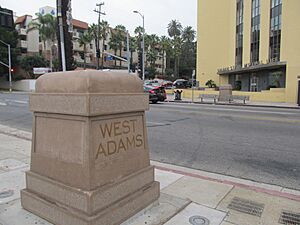
In 1949, the headquarters building of the Golden State Mutual Life Insurance Company opened. The building is a late-period Moderne structure designed by architect Paul Williams. It was once described "…as the finest building to be erected and owned by" African-Americans in the nation"
1960s - 1970s
Starting in 1961, construction of the ten-lane Santa Monica Freeway (Interstate 10) tore through West Adams' core, with the freeway routed east to west just north of Adams Boulevard. Its construction resulted in the taking by eminent domain, and demolition, of numerous West Adams homes, including a number of mansions owned by African Americans. The construction resulted in substantial displacement of West Adams residents, including the relocation of much of the area's affluent Black families. As the Los Angeles Sentinel reported:
The road could have been built without cutting through the so-called Sugar Hill section. However, in order to miss Sugar Hill, it was "said" that the route would have to cut through fraternity and sorority row area around USC. Sorority and fraternity row still stands and Sugar Hill doesn't, so you know who won out!
As in many other American cities during the heyday of Interstate Highway Act construction, interstate highway rights of way were disproportionately routed through predominantly African American communities, causing substantial displacement of residents and steep declines in neighborhood viability.
In 1971, Los Angeles Metropolitan Medical Center opened as the city’s first black-owned hospital. According to the LA Weekly , "In the 1970s and '80s it was a thriving, vital part of the West Adams community."
1980s - present day
In 2000, the Alpha Gamma Omega sorority house, a Craftsman structure built in 1911 and located in the West Adams district, received a Preserve L.A. grant from the Getty Trust.
In 2004, homes were demolished and lots were cleared in the West Adams district for what was then referred to as "Central High School No. 2". The Times reported that "a century-old neighborhood of houses and businesses" were demolished to make room for a new $130 million 15-acre high school. West Adams Preparatory High School opened in the fall semester of 2007 with a final budget of $176 million.
In 2007, the city approved the "West Adams Streetscape Enhancement Program" proposed by LANI (Los Angeles Neighborhood Initiative). Improvements included the installation of four "gateway markers" at the corners of Adams Boulevard and Western Avenue and Adams Boulevard and Vermont Avenue. Additionally, 58 magnolia trees were planted along Adams Boulevard between Western and Vermont Avenues, along with additional trees clustered near the gateway markers.
In 2011, the Times reported on neighbors pushing back against crime and wrote: "The neighborhood around them at Western Avenue and Adams Boulevard might be blighted, but they are not about to cede to urban ills their graceful streets of century-old bungalows, well-tended lawns and curbside jacarandas and towering palms."
In 2016, then-rep.(D-Los Angeles) and now mayor Karen Bass, said "I tour people through the area all the time and they are surprised when they see beautiful homes, because it's not the perception of the neighborhood." That same year, an empty West Adams Hospital was transformed into a temporary art gallery.
Geography
The City of Los Angeles
Beginning in 2000, the Eighth District Empowerment Congress began working on the "Naming Neighborhoods Project" to identify and name the communities with the neighborhood council area. Through research, a meeting with an urban historian, and numerous community meetings, sixteen neighborhoods, including the neighborhood of West Adams, were submitted to City Council in October 2001 and approved in February 2002.
At that time, the city was directed to install "West Adams" neighborhood signs on Vermont, Western and Adams Boulevards
West Adams is bounded by Western Avenue on the west, Vermont Avenue on the east, Jefferson Boulevard on the south and the Santa Monica Freeway on the north.
Additionally, the area is marked with large concrete "gateway markers" at Western and Adams and Vermont and Adams.
Historic districts
More than 70 sites in West Adams have received recognition as a Los Angeles Historic-Cultural Monument, a California Historical Landmark, or listing on the National Register of Historic Places. In recognition of their outstanding architectural heritage, there are several Historic Preservation Overlay Zones within West Adams, including:
(listed in alphabetical order)
- Harvard Heights
- Lafayette Square
- Jefferson Park
- Menlo Avenue-West Twenty-ninth Street Historic District
- North University Park Historic District
- Twentieth Street Historic District
- Van Buren Place Historic District
- Western Heights
- West Adams Terrace
Tracts and neighborhoods
West Adams is home to one of the largest collections of historic houses and small mansions west of the Mississippi River and contains many diverse architectural styles including: Queen Anne, Shingle, Gothic Revival, Transitional Arts and Crafts, American Craftsman/Ultimate Bungalow, Craftsman Bungalow, Colonial Revival, Renaissance Revival, Mediterranean Revival, Spanish Colonial Revival, Mission Revival, Egyptian Revival, Beaux-Arts and Neoclassical styles. West Adams boasts the only existing Greene and Greene house left in the city of Los Angeles.
Kinney Heights
Kinney Heights was developed around 1900 by developer Abbot Kinney, for whom it is named. It was a suburban tract of large wealthy Craftsman style houses at what was then the western edge of Los Angeles. The houses featured amenities like "beveled-glass china cabinets, marble fireplaces and mahogany floors". It was accessible to downtown via streetcar and attracted upper-class families.
Twentieth Street Historic District
The Twentieth Street Historic District consists of a row of bungalows and Craftsman-style houses in the 900 block on the south side of 20th Street.
Charles Victor Hall tract
The West Adams Neighborhood Association covers the historic Charles Victor Hall tract, dating to 1894, bounded by Western Avenue on the west, Adams Boulevard on the north, Normandie Avenue to the east, and south to Jefferson Boulevard.
Demographics
In 1985, West Adams was a predominantly "Black middle-class area with growing Latino and Korean segments, plus a mix of Hungarians, Poles, Japanese, USC students and an increasing young professional and gay population."
In 2007, it was noted that African-American gays were "eschewing the overpriced and completely gentrified territory of West Hollywood" and were instead moving to West Adams.
In 2014, the Times stated that "after a recent wave of Latino immigration", young professionals were purchasing homes in the neighborhoods west of USC, including the "stately Victorian and Craftsman mansions of West Adams" and the "smaller Craftsman bungalows" of Jefferson Park.
According to Mapping L.A., Mexican (29.2%) and Salvadoran (5.7%) were the most common ancestries in 2000. Mexico (37.4%) and El Salvador (25.1%) were the most common foreign places of birth.
Education
The schools within the West Adams neighborhood include:
- 32nd Street / USC Performing Arts Magnet, LAUSD, 822 W. 32nd St.
- John W. Mack Elementary School, LAUSD, 3020 S. Catalina St.
- Norwood Street Elementary, LAUSD, 2020 Oak St.
- Vermont Avenue Elementary School, LAUSD, 1435 W. 27th St.
- Camino Nuevo Elementary No. 3, Charter, 1723 Cordova St.
- West Adams Preparatory High School, LAUSD, 1500 W. Washington Blvd.
Recreation and parks
- Loren Miller Recreation Center, 2717 Halldale Avenue
- Richardson Family Park, 2700 S. Budlong Avenue
Transportation
The Metro E Line from Downtown Los Angeles to Santa Monica include stations in West Adams: Vermont/Expo and Expo/Western.
Notable places
- Forthmann House – 1102 W. 28th Street. Designated Historic-Cultural Monument 103 on October 4, 1972.
- Frederick Hastings Rindge House - 2263 Harvard Boulevard. Designated Historic-Cultural Monument 95 on February 23, 1972.
- John B. Kane Residence - 2122 Bonsallo Avenue. Designated Historic-Cultural Monument 500 on June 12, 1990.
- Ray Charles Offices and Memorial Library - 2107 Washington Boulevard. Designated Historic-Cultural Monument 776 on January 21, 2004.
Notable people
(in alphabetical order)
- Ray Charles, singer
- Busby Berkley, choreographer
- Louise Beavers, actress
- Pearl Bailey, actress
- Ben Carter, actor
- Clementina D. Griffin, school principal, aviator
- Lionel Hampton, musician
- Leila Holterhoff, singer, linguist, psychoanalyst
- Norman O. Houston, president of Golden State Mutual Life Insurance Company
- Little Richard, singer
- Joe Louis, boxer
- Hattie McDaniel, actress, the first African-American to win an Academy Award.
- Tim Moore, vaudeville comedian; star of CBS-TV's situation comedy, Amos 'n' Andy.
- Ramon Novarro, silent screen star
- Ivy Pochoda, author
- Ethel Waters, actress
In media
- Visiting... with Huell Howser Episode 110.
In literature
- These Women by Ivy Pochoda




